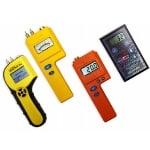A moisture meter is a handy tool to have whether you're a property owner, contractor, or inspector. You can detect moisture in a variety of hygroscopic materials, including concrete, wood, drywall, roofing, plaster, tile, brick, and paper products. Meters allow you to determine the moisture levels and if the material is ready for use or if it is at risk of damage because of excess moisture. Professional-grade meters are extremely accurate and precise — detecting hidden damp areas is where a moisture meter excels. This lets you address any issues early, potentially saving you thousands of dollars.
Why Is An Accurate Moisture Meter Reading Important?
According to Forbes Advisor, water damage comprises about 24% of all property owner insurance claims. This affects about one in every 50 property owners. Reliable moisture meter readings are essential because of the resulting effects that water has on various materials. These readings can help you prevent unchecked moisture damage that could cause:
-
Colonization of mold, bacteria, and wood-decaying fungi
-
Corrosion of building materials such as wiring, metal roofing, building materials, and other structural fasteners
-
Disintegration of water-soluble building materials such as drywall
-
Warping, cracks, and deterioration of wood materials
-
Bubbling and peeling of wall finishes
-
Damaged or reduced effectiveness of insulation
Tips to Ensure Your Moisture Meter's Effectiveness
There are things you can do to make sure you are getting the most exact reading possible:
- Make sure you’re using the right tool for the job. Each type of meter has a specific function. For example, a “pinless” meter scans larger expanses quickly and easily, while a “pin” meter more accurately defines the dispersion of moisture content throughout a specific material or in uneven areas where a pinless meter is not a practical application.
- Calibrate your meter for the material you are testing. There is not a one-size-fits-all solution for moisture meters. Different materials hold different amounts of moisture so be sure your meter is calibrated for the material you’re testing or at least has a relative scale to help define wetter areas from drier ones.
- Make sure your meter settings are correct. Delmhorst’s moisture meters come with a basic reference calibration for Douglas Fir, as that’s the USDA standard. Because species vary in moisture capacity, however, it is important to set your meter for the species or material. Check settings for temperature and also electrode - insulated or non-insulated pins?
How Long Is a Moisture Meter's Lifespan?
The lifespan of your unit will largely depend on how well-constructed it is, to begin with and of course, how you take care of it. Delmhorst is well-known for producing high-quality, robust meters and the new Navigator™ family is no exception. Count on your Delmhorst meter providing years of reliable service. You can enhance your moisture meter's lifespan with these best practices:
- Protect your meter by storing it in its hard carrying case between uses. Exposure to the elements could shorten the lifespan of your meter.
- Do not expose your moisture meter to extremes. Meters are used in all climates but continued exposure to extremes are not its friend. Continued exposure will cause premature damage to circuitry and components, resulting in faulty readings and a shorter life span for your meter.
- Do not expose it to excessive moisture. A moisture meter is sensitive electronic equipment that you should never submerge in or expose to excessive amounts of water. Keep it clean by using a damp cloth with a biodegradable cleaner. Wipe down electrodes with denatured alcohol.
- Always use fully charged batteries. Low batteries may cause faulty readings and also cause it to go out of calibration because of the lack of sufficient electric current to the meter.
How Does a Moisture Meter Save You Money?
As a property owner, you can save money by catching small problems
before they become major and cause serious damage. Insurance
claims for water damage typically involve flooding and heavy rains but a burst pipe, melting snow, leaking roof, and f
oundation cracks can all play a part in insidious damage to your home or business. Water damage can be difficult to see under carpets and between walls, so you may not detect it until the damage is massive and results in an extremely costly insurance claim.
Features to Consider
When investing in a moisture meter, some elements to keep in mind are:
- Manufacturer’s reputation. Certainly, you want to buy a product know

n for quality and after-the-sale product and application support.
- Easy to read display. The best moisture meters have LED displays that are easy to see under most conditions, and include all the necessary info at a glance.
- Built-in corrections. Best accuracy requires corrections for species, temperature, and electrode type. The user can decide which to apply, as needed.
Most moisture damage is preventable. Property owners, contracting professionals, and building inspectors can take control of issues before they begin by learning more about Delmhorst Moisture Meters.

Comments